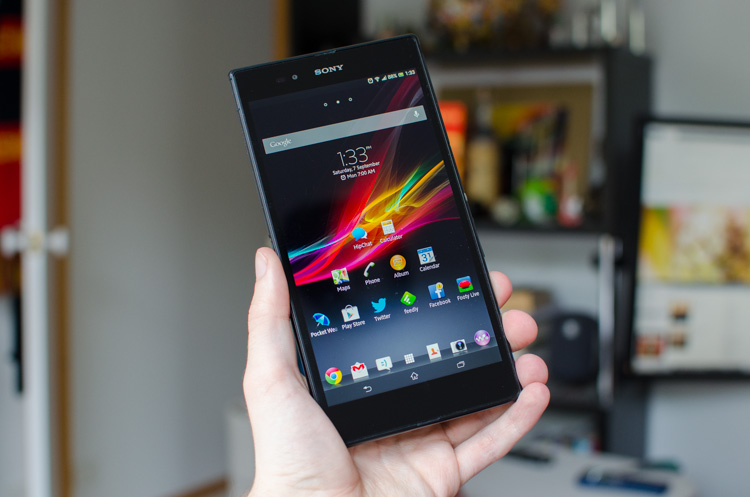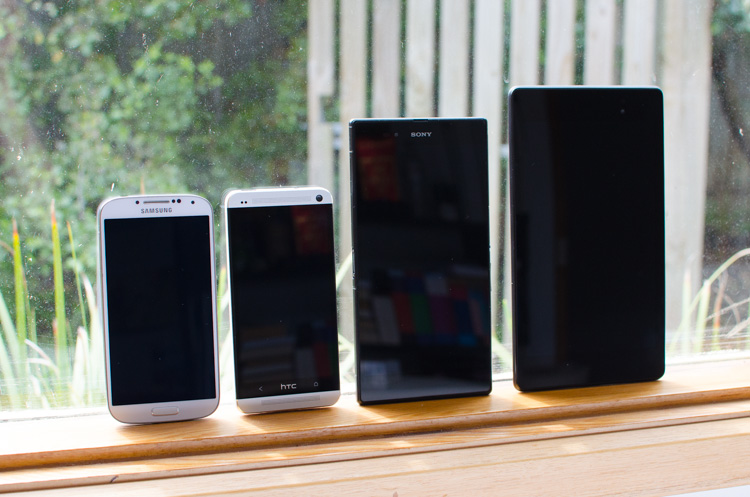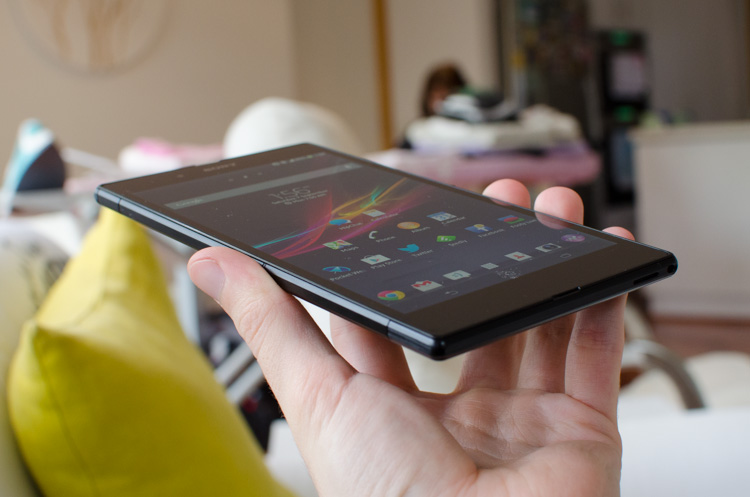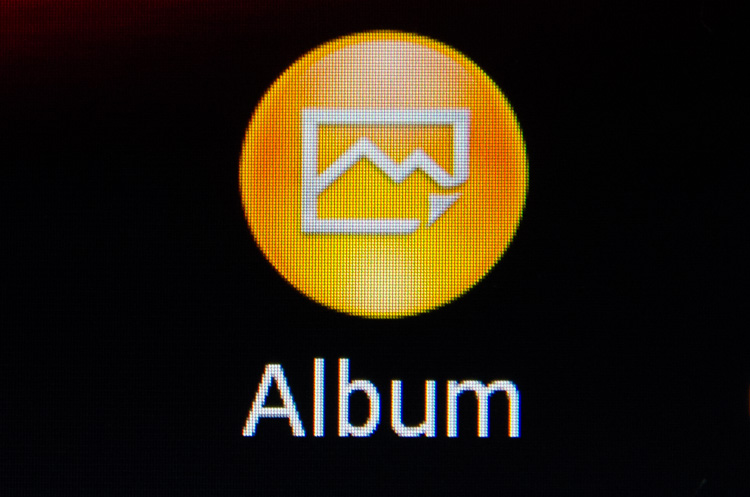With no less than 30 devices in their Xperia smartphone range, Sony certainly doesn't shy away from releasing multitudes of Android devices. This year's Xperia Z flagship is competing well against the heavyweights from Samsung, HTC and Nokia, while other phones such as the Xperia SP and Xperia E give consumers options in the lower reaches of the market. And let's not forget tablets like the Xperia Tablet Z, praised by many for its slick design and water resistance.
Sony Xperia Z Ultra - $679 (unlocked)
- 6.4-inch, 1920x1080 LCD display (344 PPI)
- Qualcomm Snapdragon 800 chipset
- 2.2 GHz quad-core CPU, Adreno 330 GPU, 2 GB RAM
- 16 GB internal storage, microSD slot
- 8 MP camera, Exmor RS sensor, f/2.4 lens, 1080p video
- IP55/58 water resistant
- 3,050 mAh, 11.6 Wh battery
- LTE, Wi-Fi ac/a/b/g/n, Bluetooth 4.0, NFC
- Android 4.2 'Jelly Bean'
- 212 grams, 6.5mm thick
However, nothing Sony has released thus far can be likened to the Xperia Z Ultra.
For the first time, the Japanese company has released a phablet, one which truly straddles the line between high-end smartphones and small tablets. A gargantuan 6.4-inch display and powerful Snapdragon 800 processor headline a list of top-end specifications, in a body that's easily the largest, but also the slimmest that I've ever seen.
The phone is not alone in the large-display market though, going up against a seasoned competitor in the Galaxy Note, with a new version launching in just a few weeks time.
Is the Z Ultra a worthy contender? Or is this device just simply too impractical for everyday usage?
The Sony Xperia Z Ultra unit used in this review was kindly provided by MobiCity. Check them out for the latest smartphones unlocked and off-contract.
Design
If I had to describe the Xperia Z Ultra in two words, it would be 'gorgeously massive'. On the one hand, Sony has crafted an astoundingly beautiful smartphone, combining a slim design with premium materials. On the other, the device is ridiculously large, pushing the boundaries of what can be considered a phone, and making it somewhat hard to use.
But I'll start with what I like about the Ultra. The entire build of the phone is minimalist, slim and appealing, making it perhaps the best Sony design yet.
Left to right: Samsung Galaxy S4, HTC One, Sony Xperia Z Ultra, Nexus 7 (2013)
At just 6.5mm thick, the phone feels really nice in the hand, and even though it's just a few millimeters slimmer than a phone like the Galaxy S4, it seems like there's a huge difference. Sony has used glass for both the front and the back of the phone, which improves the overall build quality, but can make it a considerable fingerprint magnet as well.
The model I received for review was deep black, and thanks to Sony's efforts in hiding elements such as sensors and speakers, the clean design looks undeniably classy and premium. The front speaker and microphone are kept to small lines at the top and bottom, while the main speaker is just another line on the bottom edge. Branding is also kept to a minimum, with a few Sony logos, NFC logo and Xperia logo scattered around the otherwise bare design.
Around the edges, the left side has a concealed micro-USB port at the top, and a dock connector around half way down. While the connector is magnetic, it's strange that it wasn't made flush with the edge; instead you get a small ridge that can be uncomfortable while holding the phone normally. It also doesn't quite fit with the design: upon first taking the device out of the box, I thought the volume rocker was missing.
The right-hand side features the remaining buttons and ports, including the exposed 3.5mm headphone jack, the covered microSD and micro-SIM slots, the small power button and volume rocker. Despite the power button being reasonably small, it's in the perfect spot, as it usually falls exactly where your fingers end up holding the device.
Despite the attractiveness associated with the slim, slate-like design, I am somewhat concerned about its strength. Sony claims the phone is "ultra tough", but it still exhibits a small amount of flex, both lengthwise and diagonally, which strains the large glass panels on both sides. Unlike the rock-solid Xperia Z or HTC One, there is a possibility that the Z Ultra could snap or crack in the wrong circumstances, such as if you accidentally sat on it or bent it in your pockets. That said, Sony's choice to avoid considerable reinforcement has kept the device reasonably light for its size, which improves its portability.
While the strength of the phone is somewhat questionable, clumsy people will be glad to know the phone is water resistant up to 1.5 meters for 30 minutes, and protected against low pressure water streams. Sony has coated and sealed the Xperia Z Ultra to achieve IP55 and IP58 ratings, which is part of the reason the device has flaps to cover all the ports except the 3.5mm headphone jack. Although the phone is not protected against saltwater, theoretically this IP rating means you could happily use it in a swimming pool if you so desire.
Unfortunately though, it's not possible to operate the capacitive touchscreen while the phone is submerged, or even partially submerged, in water. This limits the usefulness of the water resistance, as you can't use the camera underwater, or any feature on the phone for that matter. The only real advantage to the IP55/58 rating is protection against accidental water spills, or from dropping the phone in your bath, for example. This makes the feature more a small advantage than a key selling point.
The biggest annoyance about this phone is undoubtedly its size: it's impractical, unnecessary and sometimes downright frustrating to use. The Ultra is restricted most of the time to two-handed use, because good luck managing the massive keyboard or notification pane with one hand. Often the phone is awkward to hold and manage due to its large width, and the 5mm bezel on either side of the mammoth display doesn't help in any way. It takes practice to manage the phone in one hand without fumbling it, and that's not a good thing.
Even more concerning is the phone's vertical height of 180mm, with 17mm of bezel above and below the display. The unnecessarily large vertical bezel presents loads of issues when the device is in your pants pockets, and for the first time ever reviewing a smartphone, in day to day activities I was physically restricted carrying the Z Ultra on me. Even wearing jeans with pockets deep enough to fit the entire device, I was hindered putting shoes on, restricted when climbing stairs and uncomfortable when sitting down. It gets worse if you don't have pants that can accommodate the entire device - a situation which is reasonably likely - because it'll stick out and cause all sorts of annoyances.
So I'm stuck in an unusual situation with the Xperia Z Ultra. I love the slim, minimalist design and premium construction, but I also hate how impractical it can be in many circumstances. If only Sony had kept the display to 6-inches or lower, because if they did, we might have had a real winner on our hands.
Display: A Full 6.4-Inches
The biggest selling point of the Xperia Z Ultra is its massive, 6.4-inch 1080p display, which is perfect for content consumption. Sony hasn't specified exactly what technology is used in this display, but my instinct tells me it's a larger version of their e-IPS TFT LCD panel used on the Xperia Z. e-IPS is essentially a cost-friendly version of full IPS panels, with reduced viewing angles but largely the same color output and clarity as you'd expect from a higher-end display. At 1920 x 1080, this display comes in with a pixel density of 344 pixels-per-inch (PPI).
Sony likes to throw around a lot of marketing terms such as "Triluminous Display with X-Reality", "OptiContrast Panel" and "Mobile Bravia Engine 2" to describe the Z Ultra's display. In actual fact these just refer to a range of the display's basic features, and truthfully Sony doesn't need to use jargon like this because the display is very good.
Even though you're getting a full 113cm² of screen real-estate (compared to 69cm² with the Galaxy S4's 5-inch display), the high resolution still makes the panel very crisp. It may just be 334 PPI, which is low compared to the 450+ we're seeing on the latest high-end devices, but text looks amazing, and you can fit a lot of it on the Z Ultra's display while still keeping it readable. Images also look fantastic, again thanks to the combination of high resolution and gargantuan size.
Often the UI elements that are rendered don't do the display justice, because I've discovered that a range of applications - even those provided on the phone - don't deliver 1080p assets. It's an unfortunate situation when you have such a beautifully big display, and it's only really the first time I've noticed a lack of 1080p elements, but it's something that will hopefully resolve itself over time.
Far and away the best use of the Xperia Z Ultra's display is for movies, images and gaming. There is simply no other device that can deliver a high-quality video experience, while still (almost) fitting in your pants pockets. It even surprised me how well the Bravia Engine 2 (a software display optimizer for images and videos) works, making colors pop just that little bit more than usual. And let's not forget gaming, which is nothing short of amazing on this sizeable, high-density panel.
Color reproduction from the e-IPS isn't as good as what I've seen on the Galaxy S4's Super AMOLED, and especially the phenomenal HTC One's Super LCD 3, but it's still very respectable. Contrast is very good, as are the white levels, although like the Xperia Z, the viewing angles are lacking. You'll be wanting to view this phone directly head-on, otherwise you might experience some slight washing out to grey, but luckily this isn't a huge issue.
I was impressed by the Z Ultra display's brightness and outdoor legibility, which is no doubt improved by Sony's "OptiContrast" panel that essentially removes the gaps between glass and display. The maximum brightness is adequate for viewing the display in full sunlight, and I found the auto-brightness to adequately select the appropriate brightness based on ambient light. Naturally it's best to keep the brightness level to a minimum, because high backlight power can significantly drain the battery thanks to this huge display; something I'll explore more in the battery life section of this review.
Aside from the display itself, the Xperia Z Ultra comes with an interesting touchscreen feature that allows you to use the phone's display with essentially any conducting material, including pencils. Although the phone doesn't come with a stylus or a stylus slot in the body (which some may class as a downside), a pencil actually makes a really good substitute, providing surprisingly fast and accurate input. I also found the digitizer to work well with third-party styluses (excluding plastic ones designed for resistive touchscreens) and essentially anything metal, although ballpoint pens tend to not work due to the insulating nature of pen ink.
If you're worried about scratching the display with a metal stylus substitute or pencil, don't be, because the Gorilla Glass 3 is extremely tough and resistant to marking. While using a pencil on the Z Ultra, some graphite will deposit on the glass, then wiping the screen like you do when cleaning off fingerprints removes all traces of the pencil's contact. The same goes for pen ink, if you manage to find a pen that works well with the touchscreen.
The ability to use essentially any stylus or pencil with the Xperia Z Ultra is great because you can bring along what you find most comfortable in everyday usage. However, comparing this solution directly to the Samsung Galaxy Note II reveals some downsides. While a pencil is generally more comfortable to use than the Galaxy Note's small stylus, it lacks the additional button that can come in handy for certain tasks (like cropped screen captures). There is also no hover mode with the Z Ultra that gives you a guide to the position of the stylus above the display, which is useful while sketching diagrams.
Overall though I was impressed with the Xperia Z Ultra's display, which offers significant screen real estate thanks to a panel which is reasonably high quality. I was surprised at the smoothness of using a pencil on the screen for note-taking and navigation, and auto-brightness is a standout in working really well to manage brightness levels. It's just a little unfortunate that the screen size is such a hindrance in some situations, when it's so good for things like movie watching and mobile gaming.













